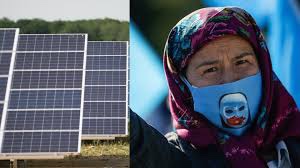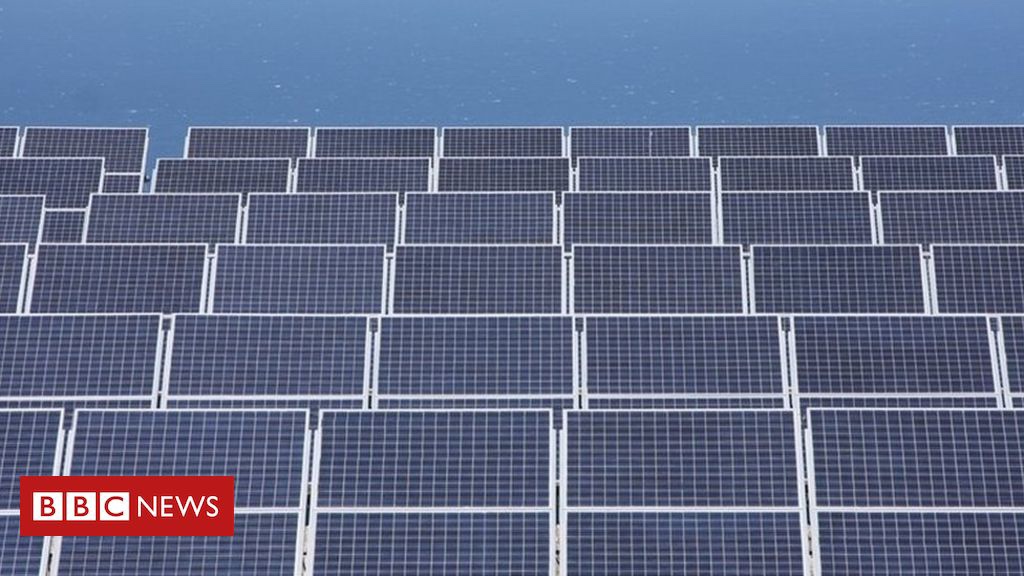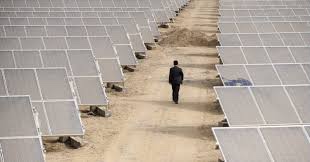
Solar industry’s ties to China’s Xinjiang region raise specter of forced labor
Lily Kuo, Pei Lin Wu and Jeanne Whalen June 24, 2021 WASHINGTON POST
Solar industry ties to China’s Xinjiang region raise forced labor concerns – The Washington Post
At a silicon factory in China’s northwestern desert, Uyghur workers man electric furnaces that reach more than 2,000 degrees. Those with college degrees can earn about $600 a month running the power supply; others inspect and load products onto trucks or crush silicon for $6.50 a ton at a sister plant farther west.
All must be able to speak Mandarin and have a clean “political record,” according to job ads for the company, Hoshine Silicon, the top producer of metallurgical-grade silicon (MGS) — the key raw material of polysilicon used in solar panels. The workers should be able to “bear hardship,” the ads say.
According to company reports, local propaganda and other public documents, Hoshine Silicon, also known as Hesheng, recruits and employs Uyghurs and other minorities via state labor programs that aim to place them in factories. Researchers say these programs are a form of forced labor for residents who, faced with the threat of detention or other punishment, cannot refuse.
The ubiquity of Hoshine’s main product, MGS — also used in construction materials, electronics, household chemicals and cars — underlines how difficult it is to divorce supply chains from claims of abusive practices.
Chinese companies in the Xinjiang region, where officials stand accused of a campaign of repression against Muslims, produce almost half the world’s solar-grade polysilicon that goes into panels sold in the United States and elsewhere. From its three factories in Xinjiang, Hoshine has produced MGS for at least eight of the world’s largest polysilicon makers, according to the company’s public statements and annual reports. Together, analysts say, these firms account for nearly all the supply of solar-grade polysilicon.
“Because they are all customers of Hoshine, the solar value chain is almost completely contaminated by forced labor,” said Johannes Bernreuter, a market research analyst who studies the polysilicon industry.
The availability of cheap coal-fired energy and labor in Xinjiang has enabled Hoshine and Chinese polysilicon makers to dominate the solar industry, making it difficult for manufacturers to replace them. Hoshine — which has previously described its hiring of minorities in Xinjiang as responding to government calls to develop the region — did not respond to requests for comment for this report.
As scrutiny of Xinjiang increases, the Biden administration has been weighing bans on imports of solar panels or components tied to the region. The Commerce Department will add Hoshine to its entity list, after concluding the company was participating in “the practice of, accepting, or utilizing forced labor,” according to a notice to be published Thursday in the Federal Register.
Solar companies are scrambling to source from suppliers elsewhere. Most of the focus so far has been on the polysilicon produced in Xinjiang.
Less attention has been paid to upstream products such as MGS, also known as silicon metal, which could taint other parts of the supply chain hitherto untouched by forced-labor claims. The material is produced through an energy-intensive process of reacting silica, or quartz, with carbon in electric furnaces at facilities like Hoshine’s in Piqan, also known as Shanshan county.
Former residents of the area say the government has sent their family members to internment camps, made them harvest cotton and take up other work, and intimidated them into ceasing contact with the outside world.
“There is no way to do standard human rights due diligence in the Xinjiang region right now or in the rest of China when it comes to forced labor from the Uyghur region,” said Laura T. Murphy, professor of human rights and contemporary slavery at Sheffield Hallam University in the U.K. and co-author of a report on the issue that also examined Hoshine.
Questions over labor practices in China’s solar industry also complicate the shift to clean energy and U.S. hopes of working with China on climate change.
At the Biden administration’s urging, Group of Seven leaders this month called on China to “respect human rights” in Xinjiang, adding separately that they were concerned by the use of “state-sponsored forced labor” in supply chains including solar.
The criticism has hit a nerve in China, where President Xi Jinping pledged to make the country carbon-neutral by 2060. Foreign Ministry spokesman Zhao Lijian on Tuesday called claims of forced labor “downright lies,” promising Beijing would make “necessary responses” to any U.S. sanctions.
The ministry declined to comment for this article, saying by phone that it would only respond to questions from journalists in China.
‘You don’t have a choice’
At Hoshine’s factories, halal food is offered in the cafeteria. The company hosts patriotic song contests; Uyghur students danced in ethnic dress during a “modern apprenticeship” program, according to a recent recruitment ad.
“Now my life is getting better and better,” Hebib Ahmati, 26, said while loading products onto a truck at Hoshine’s plant in Piqan in December, according to an article published by the propaganda department of Turpan, the prefecture to which the Uyghur-majority county belongs.
Since Hoshine set up its factory in 2015 in Piqan, an oasis at the edge of the Kumtag desert, state media has lauded the company for aiding government poverty alleviation efforts. These measures — aimed at transforming residents, mostly farmers, into industrial laborers — are increasingly under scrutiny for links to forced labor, resulting in blocks by the U.S. Customs and Border Protection of cotton, tomatoes, computer parts and other goods made by workers from Xinjiang.
State media reports, propaganda and company statements show Hoshine benefited from these programs, accepting workers who have little choice but to take the jobs where they are subjected to ideological training.
According to state media reports, between 2015 and 2020 Hoshine hired workers from Uyghur-majority areas through labor fairs for “mobilizing surplus workers,” labor transfers organized by local officials as well as a division of the Xinjiang Production and Construction Corps (XPCC), a paramilitary organization under U.S. sanctions because of alleged links to detentions and abuse.
In April 2020, Hoshine hired workers in Makit county, a Uyghur-majority district, who would be given “patriotism training” and “political assessments.” Recruits were given copies of the essential points of “Xi Jinping Thought on Socialism with Chinese Characteristics in the New Era,” according to an article by an XPCC-run development zone in Shihezi in northern Xinjiang where Hoshine operates one of its plants.
After Hoshine hosted villagers from nearby Dikan township at its Piqan factory as part of a job fair, the group was taken to the county museum of “ethnic unity education” where they “unanimously agreed that Xinjiang has always been an inalienable part of the motherland,” Murphy’s report noted, citing a post in 2017 from the Dikan propaganda office.
Such reports fail to mask the coercive nature of government programs. In an October 2020 account published by Turpan’s propaganda department, a team leader from Piqan’s public security bureau described performing “ideological work” on a villager named Muhtar to “transform his thinking” before securing him a job at Hoshine.
In another report from September 2019, officials were described as “relieving” a couple in Dikan of their seven acres of grape fields. The couple were given jobs at Hoshine, some 30 miles away, as a mechanic and product inspector, according to the state-run Xinjiang Broadcasting Station.
Former residents said refusing these jobs was not an option, given the threat of detention. “You don’t have a choice. You must go,” said Abdulla Yunus, a Uyghur from Piqan who now lives overseas.
Once hired, minority workers may be under added surveillance. Hoshine chairman Luo Liguo wrote in a 2018 article that his company had arranged for minority workers to be “supervised” by others under an “ethnic affairs” committee. In the article, Luo said his company had devoted itself to “ethnic harmony” and “stability maintenance” by hiring minority workers in Xinjiang.
A Uyghur worker at a Hoshine factory in Xinjiang, who spoke on the condition of anonymity for fear of retribution, said he voluntarily came to work at the company but faces restrictions. He speaks Chinese but is required to take Mandarin classes at the company.
He is confined to Xinjiang. “They don’t let us leave,” he said, echoing accounts of other minority residents barred from leaving. “Right now it is very strict.”
Risks ‘too high’
South of Hoshine’s Piqan factory are two high-security compounds in the same industrial park. One is enclosed by thick perimeter walls and a second layer of internal fencing, with an internal watchtower and roadblocks outside a guarded entrance, according to satellite imagery in 2018 analyzed by the Australian Strategic Policy Institute. In the other, expanses of concrete next to long, narrow buildings were hemmed in by fences, resembling prison yards.
It is not clear whether the sites, whose security structures appear to have been removed by late 2020, supplied labor to Hoshine. But they underline the industry’s proximity to repressive practices.
“The risks of doing business with that region are just too high,” said John Smirnow, general counsel of the U.S.-based Solar Energy Industries Association’s (SEIA), which has developed a “traceability protocol” that it says will ensure its members aren’t buying components or panels containing inputs from Xinjiang.
Andy Klump, a Shanghai-based chief executive of Clean Energy Associates, one of two auditors tapped by SEIA to monitor compliance, said the costs of moving away from China are too great for many. “Sure, you can remake everything in the industry in another country but it would also be very expensive,” he said, adding that there is a way to “ethically source” solar materials from Chinese suppliers not linked to forced labor.
Hoshine’s dominance makes that difficult. According to a company statement in February, its clients include the largest polysilicon makers, Chinese firms Tongwei, GCL-Poly, East Hope and Asia Silicon. Tongwei, whose production is in Sichuan and Inner Mongolia, said it has not purchased materials from Hoshine.
Hoshine named Wacker Chemie in Germany and OCI in South Korea as buyers. OCI said it had purchased raw materials from Hoshine “in the past, but the amount was not large.” Wacker said that it could not disclose information about individual suppliers.
Hoshine also sells to polysilicon maker Daqo New Energy, which supplies several of the world’s largest solar module makers. According to a corporate filing in May, a third of Daqo’s MGS last year came from Hoshine. Daqo said Hoshine was a supplier but “not its biggest,” and that Hoshine signed a pledge to prohibit the use of forced labor.
Meanwhile, MGS features widely in consumer goods, from aluminum alloys used in car manufacturing to silicones that go into cosmetics, sealants and batteries.
“The solar industry is only one of many industries that needs to reckon with the high risk of forced labor associated with being a customer of Hoshine,” Murphy said.



